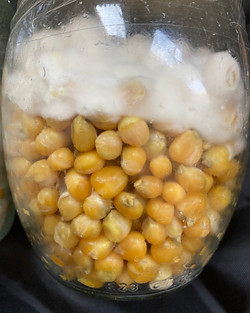
progress, flourishing

species; p. microspora, panellus stripticus
food; corn


Transferring the fungi from petri dishes to another container is quite essential for several reasons. Firstly fungi needs more space to grow, bigger than before. Also, a more loose food than agar is needed for them to breathe and spread in-between.
The corn was the second food I fed p. microspora with and they loved it! The three jars you see on the left were the second step for me when I was cooperating with the fungi.
These jars were prepared in february 2022 and they still keep growing.


What you see on the right side, in the jars, the white fluffy structure is the mycelium of the p. microspora. It is the body of the fungi, where it feeds from, breathes from. They are formed from thin filaments called hyphae and that's how they grow, by spreading through the food with filaments.





The jars to your left and also below contains woodchips and kitchen sponge (which I assume is polyurethane). And what is growing on them is again p. microspora, the star.
This was the third step for me, a change of food and environment. This was an extra exciting step for me because I would finally see how they would react with the polyurethane.
As you can see in the pictures, they started to grab the plastic however this step is still in progress.
To the below, you see the penicillium, it is not for sure the which type but it is the unwanted one. One of the common molds, responsible from the molding of the food. These jars were left with lids open for a few days and the penicillium grows on them. they are a type of fungi and they exist with me.